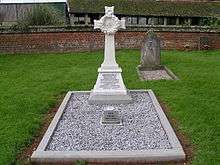Henry Hook (VC)
Alfred Henry "Harry" Hook VC (6 August 1850 – 12 March 1905) was an English recipient of the Victoria Cross, the highest and most prestigious award for valour in the face of the enemy that can be awarded to British and Commonwealth forces, for his actions at the Battle of Rorke's Drift.
Alfred Henry Hook | |
|---|---|
 | |
| Born | 6 August 1850 Churcham, Gloucestershire |
| Died | 12 March 1905 (aged 54) Gloucester, Gloucestershire |
| Buried | St Andrew's churchyard, Churcham (51°51′42.2″N 2°20′15.1″W) |
| Allegiance | |
| Service/ | |
| Years of service | 1877–1904 |
| Rank | Sergeant |
| Unit |
|
| Battles/wars |
|
| Awards | Victoria Cross |
Background

Born in Churcham, Gloucestershire, Hook originally served in the Monmouth Militia for five years before enlisting in the regular army in March 1877, aged 26. Previously serving in the 9th Xhosa War in 1877, he received a scalp injury during the battle of Rorke's Drift, and retired from the regular army 17 months later in June 1880, but later served 20 years in 1st Volunteer Battalion, Royal Fusiliers, reaching the rank of Sergeant-Instructor. He received his VC from Sir Garnet Wolseley, GOC South Africa at Rorke's Drift on 3 August 1879. After his 1880 discharge he was found the position of Inside Duster at the British Museum thanks to the intervention of Gonville Bromhead, Lord Chelmsford and the Prince of Wales. He was subsequently promoted to take charge of readers umbrellas, before resigning due to ill health in 1904.[1] During this period he lived at Sydenham Hill. He died of pulmonary tuberculosis on 12 March 1905 at Osborne Villas, Roseberry Avenue, Gloucester and is buried in St Andrew's churchyard, Churcham.
Rorke's Drift
Alfred Henry Hook was 28 years old, and a private in B Company of the 2nd Battalion, 24th Regiment of Foot (later The South Wales Borderers), British Army during the Anglo-Zulu War when the following deed took place for which he was awarded the VC. Hook and five other privates were ordered on the afternoon of 22 January 1879 to protect approximately 30 patients unable to be moved from the temporary hospital at Rorke's Drift station.
On 22/23 January 1879 at Rorke's Drift, Natal, South Africa, a distant room of the hospital had been held for more than an hour by three privates, and when finally they had no ammunition left the Zulus burst in, and killed one of the men and two patients. One of the privates (John Williams), however, succeeded in knocking a hole in the partition and taking the last two patients through into the next ward, where he found Private Hook. "These two men then worked together - one holding the enemy at bayonet point while the other broke through three more partitions - and they were then able to bring eight patients into the inner line of defence."[2]
The 1881 census shows Henry Hook V.C. as a servant in the household of George Owen Willis, a doctor in Monmouth, Monmouthshire.
The medal
His Victoria Cross is displayed at the South Wales Borderers Museum, Brecon, Powys, Wales.
In popular culture
A poem describing Hook's part in the battle of Rorke's Drift was written by William McGonagall in 1899.[3]
In the film Zulu, Hook is depicted as an insubordinate malingerer placed under arrest in the hospital, only to come good during the battle. However, Saul David writes in his book, Zulu: The Heroism and Tragedy of the Zulu War of 1879,[4] that he was there as the hospital cook, subsequently as part of a small guard detail assigned to protect the patients. Saul David continues that far from the miscreant portrayed, Hook was actually a teetotaler, Methodist preacher and model soldier.
Further to this, he had been awarded Good Conduct pay shortly before the battle. His elderly daughters were so offended at the way their father had been depicted in the film that they walked out of the premiere.[5][6] He was portrayed by English actor James Booth.
S.M. Stirling's On the Oceans of Eternity fictionalizes Hook's exploits.
Hook can also be seen in a background scene in the Alan Moore-penned comic-series The League of Extraordinary Gentlemen, vol.I, issue 6.
Related detail
In his autobiography, pop singer Mark E. Smith claimed that Hook was an ancestor of his father, which led to the Smith family being invited as guests of honour to the Whitefield showing of Zulu.[7]
References
- The Story of the British Museum by Marjorie Caygill, British Museum Press, 2nd edition 1992, p44
- "No. 24717". The London Gazette. 2 May 1879. p. 3178.
- McGonagall, William (1899). "The Hero of Rorkes Drift". McGonagall Online.
- David, Saul (2004), Zulu: The Heroism and Tragedy of the Zulu War of 1879, Penguin, ISBN 978-0-670-91474-6
- Alex von Tunzelmann, Reel History: The World According to the Movies, Atlantic Books (2015) - Google Books
- [https://www.theguardian.com/film/2010/feb/11/reel-history-zulu-michael-caine Zulu: Michael Caine loses the plot, but wins the battle: Cy Endfield's 1964 Anglo-Zulu war tale may omit the salient facts and fulsome moustaches of the real skirmish of Rorke's Drift, but it's great entertainment - The Guardian 11 February 2010]
- Smith, Mark E.; Collings, Austin (2008), Renegade - The Lives and Tales of Mark E Smith, Viking (Penguin), p. 12, ISBN 978-0-670-91674-0
External links
- Pte. Henry (Harry) Hook (biography, photos, memorial details)
- Location of grave and VC medal (Gloucestershire)
- Rorke's Drift (information within Frederick Hitch site)